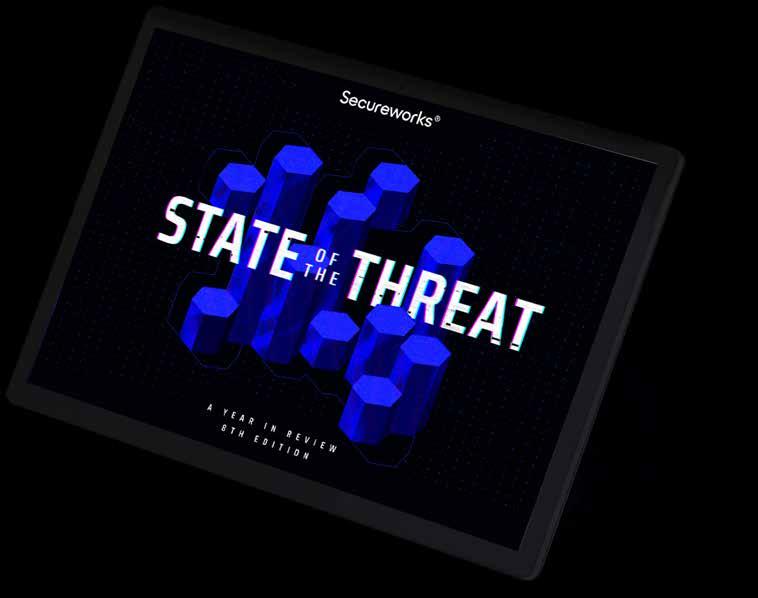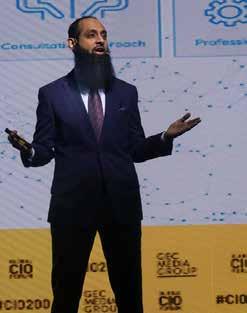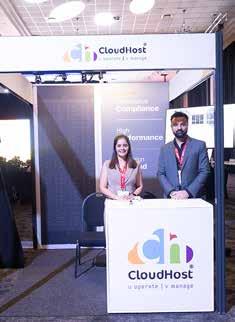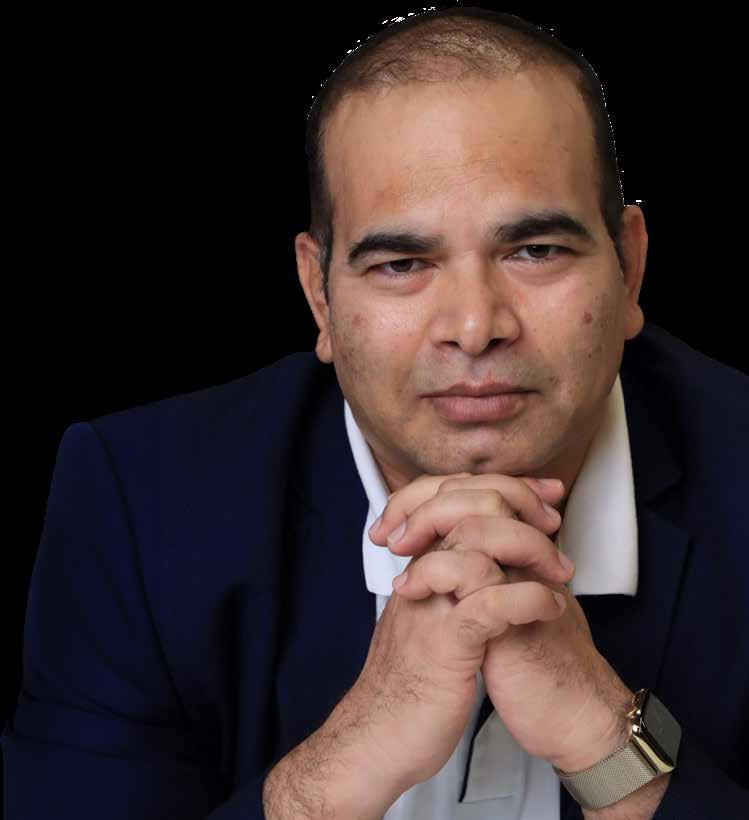CHAMPIONS OF CHANGE
The World CIO 200 Summit Grand Finale Celebrates Global Technology Leadership and Innovation







The World CIO 200 Summit Grand Finale Celebrates Global Technology Leadership and Innovation






Remember when we used to joke that CIO stood for "Career Is Over"?
How times have changed. This issue of Titans highlights the evolution of the CIO role. Not long ago, the job was all about keeping the lights on. Today, CIOs are critical in shaping business strategy, with a well-deserved seat at the leadership table. In fact, among the C-suite, the CIO is often the most suitable candidate to succeed the CEO because they have a holistic view of the business and the right skills to lead their organizations.
However, the role has never been more challenging. Beyond leading technology implementation, CIOs must strike a delicate balance between operations and innovation. Tech leaders worldwide face a common challenge: in an era of shrinking IT budgets, how can you continue to innovate and drive the business forward? How do you embrace emerging technologies while maximizing the value of existing IT investments? And how do you address the ever-present issue of technical debt?
One thing is clear—technology is the backbone of business operations today. But investing in tech just for the sake of it isn’t enough. CIOs must consider the business impact of every tech investment and pursue what remains the ultimate goal: bridging the gap between IT and business.
In this edition, we feature tech leaders from around the world who offer insights into these pressing questions. These CIOs are navigating the complex technology landscape with skill and foresight, and their stories provide valuable guidance for the path ahead.

MANAGING EDITOR
jeevan@gcemediagroup.com
MANAGING DIRECTOR
Tushar Sahoo
CO-FOUNDER & CEO
Ronak Samantaray
GLOBAL HEAD, CONTENT AND STRATEGIC ALLIANCES
Anushree Dixit anushree@gecmediagroup.com
MANAGING EDITOR
Jeevan Thankappan jeevan@gcemediagroup.com
ASSISTANT EDITOR
Sehrish Tariq sehrish@gecmediagroup.com
CHIEF COMMERCIAL OFFICER
Richa S richa@gecmediagroup.com
COMMUNICATIONS LEAD
Jennefer Lorraine Mendoza jennefer@gecmediagroup.com
CONTENT WRITER
Kumari Ambika
CREATIVE LEAD
Ajay Arya
DESIGNERS
Shadab Khan, Jitesh Kumar, Sejal Shukla
PRODUCTION RITURAJ SAMANTARAY
S.M. MUZAMIL
SUBSCRIPTIONS info@gecmediagroup.com DESIGNED BY
PRINTED BY Al Ghurair Printing & Publishing LLC. Masafi Compound, Satwa, P.O.Box: 5613, Dubai, UAE
PUBLISHED BY Accent Infomedia MEA FZ LLC Office No #115, First Floor, G2 Circular Building , Dubai Production City (IMPZ) Phone : +971 4 564 8684
31 FOXTAIL LAN, MONMOUTH JUNCTION, NJ - 08852 UNITED STATES OF AMERICA PHONE NO: + 1 732 794 5918
A PUBLICATION LICENSED BY International Media Production Zone, Dubai, UAE @copyright 2013 Accent Infomedia. All rights reserved. while the publishers have made every effort to ensure the accuracy of all information in this magazine, they will not be held responsible for any errors therein.








The most critical priority for a CIO today
The most pressing responsibility for a CIO today is ensuring that technology is a key enabler of the business’s overall strategy. This means not only maintaining IT operations but also leveraging new technologies to create competitive advantages, drive digital transformation, and enhance the customer experience. Digital transformation has become the lifeblood of modern organizations. It's not simply about adopting the latest tech; it’s about rethinking how businesses operate and deliver value in a digital age. This transformation calls for a blend of vision and pragmatism—ensuring innovative technologies are integrated without disrupting core business processes. Equally crucial is cybersecurity, which has escalated as a critical priority amid growing threats. Protecting digital assets while ensuring compliance with ever-
RASHA ALMALIK Director of Information Technology
Dar Al-Hekma University
evolving regulations is a delicate but essential balancing act.

factors contributing to the success of a CIO
For a CIO to be successful in today’s environment, a combination of strategic vision, leadership, and a deep understanding of technology is essential. Several key factors drive this success:
- Visionary Leadership: A forward-thinking approach is paramount. The ability to anticipate technological trends and assess their potential impact on the organization’s future is crucial. It’s not just about what technology can do now but about how it can position the business for the future.
- Building Strong Stakeholder Relationships: The role of the CIO has expanded to one that requires strong relationships across departments, including finance, marketing, and human resources. Communicating the strategic value of technology in clear, business-focused terms ensures alignment and buy-in from key stakeholders.
- Agility and Adaptability: Technology is evolving faster than ever, and successful CIOs must embrace adaptability. Whether it’s pivoting in response to a new market opportunity or integrating emerging technologies like AI and blockchain, the ability to remain agile in strategy and execution is vital.
- Empowering Teams: Behind every successful CIO is a strong, capable team. Fostering a culture that promotes continuous learning, and experimentation ensures that the organization
remains at the forefront of technological innovation. It’s equally important to encourage collaboration across IT and other departments, facilitating knowledge-sharing and new ideas.
- Customer-Centric Thinking: Today’s CIOs must prioritize not just internal processes but also how technology can enhance the customer experience. Whether it’s through personalization, improving service delivery, or leveraging data analytics, a customer-first mindset drives business value.
Fostering collaboration across departments
In any organization, successful technology adoption requires collaboration across departments. As a CIO, one of the most important tasks is to break down silos and foster a culture where cross-functional teams work together seamlessly. Here’s how this can be achieved:
- Cross-Functional Teams: When technology projects are driven by cross-functional teams, the resulting solutions are more likely to meet the needs of all departments. Involving representatives from different areas of the business from the outset ensures alignment and smoother implementation.
-Open Communication: Regular communication with department heads is essential to understand their technology needs and challenges. CIOs must foster an open dialogue, ensuring that IT is seen as a collaborative partner, not just a service provider.
- Shared Objectives: Technology initiatives should always be aligned with the organization’s broader goals. By demonstrating how technology projects support these objectives, CIOs can create a unified vision that encourages departments to collaborate.
- Utilizing Collaboration Tools: Technology itself can be a great enabler of collaboration. Implementing tools that facilitate communication, project management, and document sharing helps to bridge gaps and create a more connected workforce.
Staying up-to-date with the latest innovations
The rapid pace of technological advancement makes it critical for CIOs to stay ahead of trends. Here are strategies that need to be employed to ensure remain informed:
- Engage in Continuous Learning: Attending industry conferences, workshops, and webinars helps me stay on top of emerging technologies. Networking with other CIOs and thought leaders allows me to learn from their experiences and gain insights into the latest trends.
- Leverage Vendor Relationships: Technology vendors often have deep insights into future trends and innovations. Building strong partnerships with vendors allows CIOs to stay informed about what’s next on the horizon and gives early access to new technologies.
- Encourage Experimentation: Within the IT department, We
promote an environment where experimentation with new technologies is encouraged. Whether it's through innovation labs or allowing staff time to explore new tools, this hands-on approach ensures we are constantly pushing the boundaries of what technology can offer.
- Reading and Research: Staying informed requires constant reading of industry reports, academic papers, and technology blogs. Insights from Gartner, and other leading organizations provide a broader perspective on where technology is heading.
Striking the balance between operations and innovation Balancing operational stability with the need for innovation is a tightrope that all CIOs must walk. On one hand, maintaining the organization’s technology infrastructure and ensuring smooth day-to-day operations is essential. On the other, driving innovation is critical for longterm success.
- Establish Clear Priorities: It’s important to separate operational objectives from innovation goals. Both need their own set of priorities and resources.
- Create Innovation-Focused Teams: created dedicated teams that focus solely on innovation, while other teams manage ongoing operations. This separation allows each team to specialize and excel in their respective areas.
Addressing the biggest

challenges facing CIOs Today’s CIOs face a range of challenges, from cybersecurity threats to managing talent shortages. Here’s how these challenges can be addressed:
- Cybersecurity: With the rise in cyber threats, the need for robust cybersecurity measures has never been greater. I advocate a multi-layered approach, combining strong security protocols, continuous monitoring, and ongoing employee training to mitigate risks.
- Talent Shortages: The demand for skilled IT professionals continues to grow, making it challenging to find and retain top talent. We address this by investing in our team’s professional development, fostering a culture of continuous learning, and offering competitive benefits.
- Legacy Systems: Many organizations still rely on outdated technology, which can be difficult to integrate with modern solutions. Addressing this involves a gradual approach, where legacy systems are phased out and replaced
with more flexible, scalable alternatives.
- Budget Constraints: Technology initiatives can be expensive, and justifying the cost to the broader organization is a constant challenge. The key is to demonstrate clear ROI by showing how technology investments align with and drive the organization’s strategic objectives.
- Managing Remote Workforces: With the rise of hybrid and remote work, ensuring that employees have access to the right tools and technologies has become a priority. Investing in cloud-based infrastructure, cybersecurity, and collaboration tools is essential for managing a distributed workforce.
In conclusion, the modern CIO must be both a visionary and an operational expert. By focusing on aligning technology with business goals, fostering collaboration, staying ahead of trends, and balancing innovation with operational excellence, today’s CIO can lead their organization to sustained success in a digital world.
The role of the CIO today is equally exciting and challenging. It has evolved significantly since pre COVID as technology and digital data have become pervasive, ubiquitous and vital to business success. Today's CIOs is not only about quality of service, cost effectiveness and delivery of strategy, it must also understand how technology supports and drives change and business transformation through agility, innovation and experimentation. With this the most critical priority for today’s CIO is attracting, building and retaining talent whilst balancing operational excellence with innovation.
In my opinion, the single biggest success factor for a CIO is delivery, tangible business outcomes and positive impact, grounded in trusted, value adding business and strategic partnerships. No CIO is an island. They must be seen to be a
supportive, trusted and valued member of an organisation (at all levels) and in doing so be seen to be value adding vs an obstacle to progress, ideas and innovation. However, with this, it must be acknowledged and understood that the CIO is responsible and accountable for the technology stack and pragmatically ensuring the security and resilience of an organisations data, systems and services.
The only wayto do this is to build positive


business relationships, invest time in people (face to face wherever possible), understand their objectives, challenges and issues and add value.
The role of the CIO is an incredibly privileged, holistic position in touching and spanning every person, within every department, across an organisation. It is uniquely placed to identify common opportunities, solutions and benefits to organisations, and bring people together to co-create, progress and realise these.
Technology is changing so quickly it is virtually impossible to keep abreast of all the latest innovations and trends in technology.
That is where resources such as business stakeholders, team members, industry publications, conferences, events, podcasts, papers, CIO networks and strategic partners are all important and valuable sources of information, ideas and thinking.
It is a common challenge to ensure equal time is spent on maintaining operations in areas such as availability, resilience, security and disaster recovery which are foundationally important, as well as innovation and experimentation to help a business transform and move forward. However, we should not lose sight that innovation can help, support and enhance
operations the two are not mutually exclusiveand can complement each other.
YOU ADDRESS THEM?
Aligned to the fast pacing change in technology, increasingly and more than ever before CIO’s (and their teams) are being asked to deliver more, faster, with less (resource and budget).
Therefore agility, smart working, organisational prioritisation and the ability to say ‘No’ or ‘Not Yet” are becoming essential skills in managing personal and team stretch vs stress, wellbeing and organisational alignment and support. The best CIO’s have found this balance, sustained value adding delivery and maintained their valued position within their organisation.

Driving digital transformation across the organization through data, AI, and customer experience, with an increased focus on security, remains our top priority.
From my perspective, the most important factor is a
CIO's ability to communicate effectively—both with leadership for strategic alignment and with IT team members to inspire and motivate them. Following that are:
1. Having a strong understanding of IT to evaluate technology options, while also possessing a deep understanding of the business or industry they are part of.
2. Staying up to date with the latest advancements in technology and best practices. I could go on to mention aspects like the ability to anticipate and mitigate risks, but I would prioritize the factors mentioned above when evaluating a CIO.

We promote a culture of collaboration within IT and across different departments. Encourage open and transparent communication between departments through regular meetings, emails or instant messaging leveraging MS Teams. When it comes to specific projects or initiatives, we organize cross functional teams along with IT team members to promote shared ownership
MOHAMED ANISH
Group CIO
Lulu Group International
and understanding of different perspectives.
Attending conferences, seminars, webinars, and trade shows provides us with valuable insights into emerging technologies and best practices. Certain events also offer the opportunity to experience these technologies firsthand and connect with technology vendors, with whom we may want to collaborate on Proof of Concept (PoC) or Proof of Value (PoV) implementations. Continuous collaboration with existing technology vendors is also crucial for staying informed about the latest developments. I also subscribe to industry publications and blogs to stay current on the latest trends and advancements. Of course, following thought leaders and industry peers on social media is another effective way to keep up to date.
Most important aspect that we follow when it comes to innovative initiatives is to pick them based on their alignment with Organization's strategic goals. In fact, most of the innovations that we do are part of the efforts that we put into continuous improvement of our operations. These improvements are then measured on and necessary tweaks are brought in, as and when needed. The IT functional consulting leads are given the responsibility of
fostering a culture of Innovations within their team and their function counter parts in the business team. We are also blessed with a leadership team, who backs us while we take calculated risks while trying out Innovative ideas or trending technologies.
If I were to shortlist key challenges, the following stand out: Talent Shortage and Skills Gap -One of the primary challenges we face is the difficulty in finding and retaining skilled IT professionals. To address this, we have implemented several strategies. Firstly, we focus on setting up facilities in regions where the necessary talent can be acquired more easily. For example, we recently established a Center of Excellence for Analytics in Bangalore, India, to tap into the rich talent pool there. Additionally, we invest heavily in employee development and training programs to upskill our existing workforce. In certain cases, we explore alternative hiring models like outsourcing and employing contract workers to manage temporary backlogs or meet niche expertise needs. Furthermore, we have started leveraging automation and AI to augment human capabilities and fill certain gaps more efficiently.
Cybersecurity Threats - The ever-evolving threat landscape, including ransomware, phishing, and data breaches, poses a constant challenge. As a leading brand, we are frequently targeted
by malicious actors. To mitigate these risks, we have set up a robust security infrastructure, including firewalls, intrusion detection systems, and encryption. We conduct regular security audits and assessments to ensure our defenses are up-to-date. Additionally, we have developed incident response plans to address security incidents promptly.
Recognizing that humans are often the weakest link in a security landscape, we conduct regular training and awareness campaigns to educate employees on security threats and best practices. Moreover, we have added more weight to assessing the cybersecurity practices of vendors during the evaluation process, as well as reassessing those practices with existing partners to ensure compliance and minimize risks.
Data Privacy, Compliance, and AI Compliance- Adhering to complex data privacy regulations such as PDPL and GDPR is another significant challenge, especially as AI compliance becomes more critical. To address this, we are running comprehensive data privacy programs that involve conducting impact assessments, implementing data protection measures, and performing regular audits. We are also strengthening our data governance policies to ensure that we remain compliant with evolving regulations and maintain the trust of our customers.
These measures help us stay ahead of challenges and continue operating securely and efficiently in an increasingly complex digital environment.
In today's fast-paced world, the priorities of a CIO are constantly evolving. However, I believe that the most critical priority remains data security and protection. In non-profit organizations like the Royal Humanitarian Foundation (RHF), we handle sensitive data related to vulnerable groups in society, such as orphans and widows. This data includes personal and financial information that can be targets for cyber threats. Thus, the primary priority is to build a secure and reliable IT infrastructure. In this context, we are proud to have achieved ISO 27000 certification for Information Security, which underscores our commitment to the highest global standards in data protection. This involves implementing multi-layered strategies, such as data encryption, advanced firewall systems, and identity and access management solutions to ensure unauthorized individuals do not access sensitive information. Additionally, we focus on continuous employee training to raise awareness about cybersecurity risks and ensure they are
prepared to handle any potential threats. Our efforts also include conducting regular penetration tests and simulating cyber-attacks to ensure our systems and infrastructure are ready for any potential breaches. This proactive approach helps us identify vulnerabilities and address them promptly, ensuring the protection of our data and the trust that our beneficiaries and donors place in the organization.
Several factors contribute to the success of a CIO, but I would focus on three main ones: strategic leadership, the ability to communicate and collaborate, and flexibility in adapting to change. Firstly, strategic leadership is crucial. At the Royal Humanitarian Foundation, we do not use technology merely for the sake of modernization or to show off; rather, it is to empower our humanitarian goals. This requires a CIO to have a clear vision of how technology can enhance the organization's operations and achieve its objectives. They must be able to devise long-term strategies and prioritize technology investments based on the expected impact on beneficiaries and the community. Secondly, the ability to communicate and collaborate is vital. The CIO's role is pivotal in bridging technology with the organization's daily operations. To achieve this, a CIO must be able to speak a language that everyone understands, whether they are technical or nontechnical, and work closely with leaders from different departments to ensure technology aligns with business needs. Finally, flexibility and adaptability to change are keys to success in the technology field,

HASAN ABDULAZIZ MURAD Director of Information Technology Department Royal Humanitarian Foundation, Bahrain.
where the landscape changes rapidly. A CIO must be constantly aware of the latest innovations and developments and be able to adopt new technologies quickly if they align with the organization's goals.
In an organization like the Royal Humanitarian Foundation, success heavily depends on collaboration across different departments. No department can work in isolation. For instance, the success of fundraising campaigns relies on close cooperation between the public relations team, the IT team, and field teams. To support this collaboration, we have adopted shared technology platforms such as project management systems and collaborative communication platforms that allow different departments to work together in real time. We have implemented a unified donor and beneficiary management system that enables secure and seamless information exchange between public relations, IT, and field support teams. Furthermore, we organize joint workshops and training programs to enhance mutual understanding between different departments. For example, we may hold a joint workshop between the IT team and the field team to understand the challenges each faces and how technology can play a role in streamlining operations and achieving the organization's goals.
As an IT leader in a humanitarian organization, keeping up with innovations and technological trends is crucial to ensuring we provide innovative and sustainable services to beneficiaries and donors. We rely on several methods to stay abreast of technological developments: Firstly, participation in conferences and seminars is an effective way to stay updated on the latest advancements. These events provide a platform to exchange ideas and experiences with industry leaders and innovators. We also engage in training courses and workshops organized by wellknown tech organizations, helping us enhance the skills of our IT team. Secondly, we leverage partnerships with tech companies and benefit from reports and studies from research firms like Gartner and Forrester. These sources provide valuable insights into future trends and help us make well-informed decisions. Lastly, we encourage an open innovation approach within the organization. This means we listen to ideas and suggestions from all departments and seek to bring in new ideas from outside the organization, whether from donors or the beneficiaries themselves.
Balancing operation and innovation is a major challenge for any CIO. At the Royal Humanitarian Foundation, we ensure a constant balance between improving daily operations and exploring new technologies. To achieve this, we follow several strategies: Firstly, we allocate
separate resources for innovation. We have dedicated teams that work on developing new projects and improving processes through technology without impacting day-to-day operations. This helps us achieve innovation without compromising the quality of services provided. Secondly, we use automation technologies to enhance operational efficiency. Automation reduces human errors and helps speed up processes, allowing us to save more time and resources for innovation. For example, we rely on automating the process of collecting and analyzing data from our various projects to provide accurate and timely reports. Question 6: What are the biggest challenges currently facing CIOs, and how would you address them? There are several challenges facing CIOs today, but I believe the major challenges involve adapting to rapidly changing technology while maintaining budget sustainability. In a non-profit organization, the budget challenge is more complex because we work with limited resources. To overcome these challenges, we follow a hybrid strategy that combines gradual investment in new technologies and upgrading existing systems in a way that does not hinder operations. We also adopt best security practices and continuously develop our infrastructure, focusing on solutions that provide maximum value at minimum cost. One example is the use of cloud technologies to improve efficiency and reduce operational costs. We use cloud services to store data securely, allowing us to access data easily and in real-time while maintaining security and compliance standards.


The 2024 World CIO 200 Summit Grand Finale, hosted in Johannesburg and Cape Town, South Africa, set a new standard for excellence in celebrating global technology leadership.
More than 200 CIOs, CISOs, and visionaries from all corners of the world came together in a dazzling show of collaboration, innovation, and leadership, igniting the future of digital transformation like never before.
Hosted by the Global CIO Forum, this summit was the pinnacle of a 50-country journey. It was a gathering of tech pioneers, the brightest minds in the industry, who didn’t just meet to talk but to redefine the future of business.
Here is how it unfolded over four days.
Day zero
Day zero saw guests welcomed and checked in, collecting their event badges, access passes, and merchandise in preparation for the excit-
ing activities and networking sessions ahead. A key highlight of the opening day was the Archery Challenge 2024, powered by Sentient Archery. Over 100 CIOs participated in this thrilling test of precision and leadership, aiming to hit the bullseye and claim the title of Archery Champion. The activity not only tested physical prowess but also symbolized the sharp decision-making and accuracy required of top IT leaders in today’s fast-evolving tech landscape. This activity was sponsored by Quixy.
Following the adrenaline-pumping archery competition, the day shifted to a more relaxed and celebratory tone with a spectacular tribute show, “SIMPLY THE BEST”, celebrating the greatest musical icons of all time at The Barnyard Theatre, Emperors Palace. Attendees were treated to an unforgettable performance, bringing a blend of music, entertainment, and nostalgia to close out the first day of the summit.
The evening concluded with the World CIO 200 2024 Grand Finale


Welcome Dinner held at the iconic Tribes African Steakhouse & Grill. Guests savored the finest in African cuisine while reflecting on the day’s accomplishments and gearing up for the summit’s key discussions and presentations over the following days.
Day one
Day one of the prestigious World CIO 200 Grand Finale unfolded at the Birchwood Hotel & OR Tambo Conference Centre, marking an extraordinary gathering of global CIOs, IT thought leaders, and industry innovators. The event kicked off with an early morning Breakfast & Networking session,
where attendees engaged in meaningful conversations and exchanges over coffee. The relaxed networking atmosphere set the tone for a day packed with enriching content and discussions, all centered on technology leadership and innovation.
The day officially began with a welcome


note delivered by Ronak Samantaray, Cofounder and CEO of GEC Media Group, who set the stage for the remarkable sessions that followed. His welcome speech highlighted the significance of global collaboration in addressing the evolving technological landscape, emphasizing the role of CIOs as strategic enablers of digital transformation. Jeevan Thankappan, Managing Editor of GEC Media Group, followed with an Editor’s Note, offering a deep dive into the event’s

core theme and discussing how technology can transcend borders and create a global impact. He recognized the growing importance of digital leadership in the face of emerging global challenges, reinforcing the need for innovation and collaboration.
The morning sessions continued with Charbel Zreiby, Regional Director, Channel Data Center Specialists at Dell Technologies, delivering a keynote focused on the transformative power of AI across industries and
the importance of embracing AI to stay competitive in a rapidly evolving technological landscape.
His presentation was followed by the next keynote by Ricky Kej, three-time Grammy Award Winner and United Nations Goodwill Ambassador, who shared his thoughts on “Uniting Cultures, Transcending Borders.” Sharing his journey as a musician and environmentalist, Ricky emphasized the interconnectedness of music and nature. After 13 years of producing over 3,500 commercials, he decided to stop producing commercial music and instead focus on creating music that addresses social and environmental issues.
This was followed by thought-provoking session by Alan McSmith, a wilderness guide from South Africa, who discussed the importance of connectivity and being human, emphasizing the inclusion of future generations and non-human entities as stakeholders.
His presentation invited the audience to reflect on their perceptions and navigate




14-18 OCT 2024






through existential crises by facing fears and changes beneath the surface, using an anecdote from the Okavango Delta to illustrate this concept.
Ali El Kontar, CEO of Zero&One, took the stage next, emphasizing leadership and personal accountability. To foster change in an organization, leaders must be the change they wish to see in others, taking ownership of problems and actively seeking solutions. This modeling of behavior will encourage others to follow suit, improving teamwork and performance, he said.
This was followed by a presentation from Amit Veer, Founder & CEO, Coffeee.io-merchandise sponsor of the event- focused on


offshoring with AI-powered tech recruitment, addressing the global tech talent shortage, particularly in industries like software engineering. He highlighted the key benefits of offshoring, especially to India, which offers a large pool of skilled tech professionals at lower costs, 24/7 operations, and no language barriers.
The presentation from Raif Abou Diab, Country Manager - South Gulf & Sub Saharan Africa at Nutanix highlighted the significance of Nutanix's hybrid multi-cloud platform and its role in simplifying IT environments. The key message is that Nutanix enables organizations to run applications and data across various environments, including on-premises,

private, and public clouds, with a unified platform.
The afternoon kicked off with a sumptuous lunch and networking session, allowing attendees to connect further and reflect on the discussions from the morning. Following lunch, the Leadership Masterclass was led by Dr. Antoine Eid, founder of Meet YourSelf, which is the world’s first science-based workplace DNA assessment and reporting tool that combines three key scientific areas together to deliver the most comprehensive and applicable results for performance at the workplace.
In the evening, the spotlight turned to the much-awaited Ambassadors Meet, an invite-only session that brought together ambassadors of the World CIO 200 2024 initiative. The exclusive gathering fostered deep discussions on leadership challenges and opportunities, with ambassadors sharing their experiences in driving technological advancements across various industries.
As the day transitioned into night, the event’s grand Gala Dinner commenced, starting with an opening note by Richa S, Chief Commercial Officer of GEC Media Group. The dinner provided a perfect blend of celebration and recognition, highlighted by a stellar performance from Manoj George, an internationally renowned violinist and music

composer, alongside Ricky Kej, whose uplifting melodies symbolized the spirit of positivity and cultural diversity.
The event continued with the Ambassadors Recognition ceremony, where outstanding global leaders were honored for their exceptional contributions to the GCF community and the broader IT industry. This was followed by the presentation of the GCF Preferred Partner Awards, recognizing key partners who played a significant role in advancing the goals of the Global CIO

The day commenced on a serene note with a Mental Wellbeing Program led by worldrenowned Yoga Guru Sumit Manav. His session, titled “Mindful Meditation – An Inward Journey,” focused on nurturing mental wellbeing, a vital aspect for today’s leaders. In a world driven by fast-paced technological change, Sumit emphasized the importance of grounding oneself through mindfulness, enabling leaders to manage stress and

maintain a sense of balance in their personal and professional lives. The participants were guided through meditation techniques aimed at fostering clarity and focus—qualities essential for navigating complex decision-making processes.
Venkatesh Mahadevan (Venki), Board Member of CaaS, delivered an insightful opening address titled “Moving the Needle” through storytelling and real-world examples of transformation. He highlighted key examples from around the world, emphasizing the





power of accessibility, collaboration, and innovation in driving change.
Venki inspired the audience to identify ways in which they can "move the needle" in their respective fields, stressing that even a single idea can create significant change.
He encouraged a mindset of collective action and innovation, asking leaders to consider their roles in shaping the future, especially with innovations like AI and ChatGPT. He closed with a powerful reminder: "Do not die with the music inside your head," encouraging the audience to share their ideas and foster innovation rather than holding them back.
The address was a mix of humor, inspiration, and deep reflection, leaving the audience motivated to take action and create lasting change in their organizations.

The morning session featured a lineup of influential speakers sharing thought-provoking insights:
• Mohammed Abdul Hadi, Director of Enterprise Infrastructure Solutions at StorIT Distribution, delivered the Partner Keynote, highlighting the future of enterprise infrastructure and the evolving role of technology in driving growth and operational efficiency.
• Aphiwe Qhama Menziwa, Founder of Tembisa Ratanga, took the stage with an inspiring talk titled “A Place of Hope,” where he shared the story of how his organization is transforming lives in disadvantaged communities, showcasing the power of technology in driving social change.
• Mayuresh Kothari, Technical Director at
Secureworks, provided a keynote focusing on cybersecurity and the growing challenges of protecting digital ecosystems in an increasingly interconnected world.
• Jayakumar Mohanachandran, CRO of CaaS Research, shared his insights on “AI Foresights and Outlook 2024-25,”offering a glimpse into how artificial intelligence will shape industries and redefine the future of business. His insights provided valuable context for CIOs as they plan for AI integration into their operations.
Technology and Innovation Presentations
The technological landscape took center stage as thought leaders shared groundbreaking insights:
• Gautam Nimmagadda, CEO of Quixy, introduced “The Power of No-Code Platforms for Seamless Applications.” His talk underscored the efficiency and agility that no-code platforms offer for businesses to rapidly develop and deploy applications, reducing dependency on traditional development cycles.
• Rajeev Dutt, General Manager of SwissGRC, joined virtually for a session titled “GRC for Strategic Excellence and Operational Resilience,” shedding light on how governance, risk, and compliance solutions are integral to building
Later in the day , Sumit Manav returned to the center stage to captivate the audience with a second session, “Your Path to Lifelong Wellbeing.” Building on his earlier meditation program, Sumit offered actionable tips for embedding mindfulness practices into daily routines, empowering leaders to achieve sustained mental clarity and physical vitality.
The last of the morning’s partner keynotes was delivered by Caryn Vos, Senior Manager of the Crypto Division at Altron, who said the company has become a trusted leader with a full stack of solutions that bring centralized security controls, policies, and compliance into heterogeneous and dynamic hybrid cloud environments
The highlight of the afternoon was a Leader-
ship Masterclass led by Haragopal Mangipudi, the founder of guNaka, renowned keynote speaker, and author. The session, specifically tailored for CIOs, delved deep into the complexities of modern leadership.
Global CIO Forum Finale: Reflections and Future Outlook
The event concluded with a reflective session led by Anushree Dixit, Global Head at GEC Media Group, where she recapped the highlights of the forum and discussed the future outlook for the CIO community. Her talk served as a call to action for all attendees, inspiring them to implement the knowledge gained over the course of the forum to shape the future of their organizations.
Anushree also hosted the highly anticipated Day 2 Lucky Draw, adding an element of excitement to the closing moments of the event.
With the formal proceedings concluded, attendees prepared to depart from the hotel to catch their flight to Cape Town. This marked the beginning of the next chapter of their journey as leaders, armed with insights, connections, and strategies gained over the course of the Global CIO Forum.
The final day of The World CIO 200 2024 Finale unfolded in Cape Town with a dynamic blend of excitement, exploration, and celebration, offering attendees an unforgettable experience that encapsulated the spirit of innovation, adventure, and connection.
The participants took part in the Harley Davidson Chauffeur Rides. This thrilling experience allowed guests to discover the scenic beauty of Cape Town from the seat of legendary Harley Davidson motorcycles, alongside vintage cars, which offered a nostalgic yet exhilarating touch to the journey. As the riders roared through Cape Town’s picturesque routes, braving the rain, the energy was palpable, and the scenic beauty of the Cape left an indelible mark on everyone. This high-octane adventure provided a unique and memorable way to immerse in


the natural splendor of the region, blending adventure with exploration.
Following the excitement of the morning rides, attendees were treated to a serene and indulgent picnic and wine tasting at the renowned Simons Restaurant located at Groot Constantia, one of South Africa’s most iconic wine estates. The afternoon was marked by relaxation, where participants savored a selection of fine wines while enjoying gourmet delicacies in the peaceful ambiance of the vineyard. Surrounded by lush landscapes and centuries-old winemaking traditions, the wine tasting offered a luxurious pause in the day’s activities, giving everyone a chance to unwind and relish
Cape Town’s culinary and viticultural excellence.
As the day progressed, attendees were given some well-deserved leisure time, allowing them to relax, explore Cape Town further, or reflect on the week’s transformative discussions and experiences. This break provided a personal moment for attendees

to recharge before the evening’s highly anticipated events.
The highlight of the evening was the electrifying session featuring husband and wife adventurers Chris and Julie Ramsey, who shared their experiences from their pole to pole expedition in an EV.
Their talk, titled “Charged for Change: The Electrifying Journey of Chris and Julie Ramsey,” delved into their passion for adventure and sustainability, showcasing how they had overcome challenges along the 17,000 mile route.
In every way, the final day was a fitting conclusion to The World CIO 200 2024 Finale, blending adventure, relaxation, insightful discussion, and celebration. The day left participants with a profound sense of community and a shared commitment to innovation and transformation in the tech world. The finale will be remembered not only for its high-profile speakers and engaging activities but also for the inspiration and connections it fostered among the global CIO community.
Actionable, AI-powered insights across any environment.

Digital transformation has become the top priority for CIOs, particularly in industries such as architectural engineering and construction (AEC). The need to integrate emerging technologies, build interconnected platforms, and optimize operations is paramount. CIOs who leverage artificial intelligence (AI), augmented reality (AR), and generative design can revolutionize project delivery. AI enhances design optimization for energy efficiency, AR improves visualization, and generative design tools offer innovative solutions by exploring endless possibilities.
The modern CIO must balance being a technology expert, business strategist, and change leader. Success hinges on their ability to not only lead the IT function but to align it with business objectives,


drive innovation, and guide our organizations through a rapidly changing digital landscape. Leadership, adaptability, and a strong understanding of both business and technology are key to thriving in this increasingly pivotal role.CIO is a change leader, and the digital presents substantial competitive advantages and longterm business growth prospects.
HOW DO YOU FOSTER AND SUPPORT COLLABORATION ACROSS DIFFERENT DEPARTMENTS?
Fostering collaboration across departments requires a combination of clear goals, the right tools, supportive leadership, and a culture that values employees and teamwork. I personally encourage open communication, forming cross-functional teams, using collaborative technology if possible, and trying to remind myself and my management team to celebrate success, since in the busy of the day – this is most important.
HOW DO YOU KEEP UP WITH THE LATEST INNOVATIONS AND TRENDS IN TECHNOLOGY?
I read a lot, and when it comes to keeping up to date, I’m finding it X and LinkedIn to be the best tools.
HOW DO YOU STRIKE THE BALANCE BETWEEN OPERATION AND INNOVATION?
We delineate between two IT roles, one Operations or RUN and other Innovation or BUILD. Balancing starts from the Budget to the retirement of the service portfolio. We start by ensuring that any innovation efforts are closely aligned with the core business objectives, aiming to improve operational efficiency, enhance customer experiences, or open new revenue streams, without disrupting essential day-to-day operations. Most of our IT departments have a structure that supports both stable operations and forwardlooking innovation efforts, using dedicated resources for innovation, and fostering a culture of continuous improvement –
innovating through many pilot projects that find its way into the operations.
WHAT ARE THE BIGGEST CHALLENGES CURRENTLY FACING CIOs, AND HOW WOULD YOU ADDRESS THEM?
We face a complex mix of challenges today, driven by rapid technological advancement, evolving business needs, and external pressures such as cybersecurity risks and regulatory demands. The demand for tech talent, especially in fields like AI, cybersecurity, and data science, far exceeds supply, which places a greater focus on upskilling and reskilling, leveraging remote work, and offering innovative workplace culture and competitive benefits. We try to leverage automation to address as many resourcing issues and adopt agile frameworks, however, the culture is key for CIOs because it forms the foundation upon which technological strategies, innovation, and collaboration thrive.
Adaptability is the most critical priority for any CIO because it is essential for navigating the rapidly evolving technological landscape and aligning IT strategies with shifting business goals. In an extremely dynamic environment where new technologies, market demands, and external threats constantly emerge, a CIO’s ability to adapt is fundamental to an organization's success.
In addition to adaptability, as a CIO in the hospitality industry, my journey has been shaped by two other essential forces: courage and ambition. In an industry driven by guest experiences, the responsibility of managing technology and innovation falls on my shoulders. This is no easy feat, especially in a world where technology evolves at a dizzying pace, and guest expectations grow more sophisticated each day.
I believe the acceleration of digital transformation in the hospitality industry over the last few years has pushed us all into uncharted territory. As a CIO, I’ve had to make bold decisions, sometimes without the full picture. Technology is ever-changing, and innovations that seem groundbreaking today may be obsolete tomorrow. In these moments, courage is about embracing the unknown and trusting in my ability to lead.
In a nutshell, the ability to make bold decisions, the willpower to keep unlearning and relearning (upskilling), ambition to continuously seek out new opportunities to push the organization forward, and the unique capacity to focus on the bigger picture have contributed to the most successful innovations.
I am a strong believer in teamwork and cohesion. I have continuously achieved this by creating a unified vision where the team understands that all innovations are driven by the shared goal of improving operations, streamlining processes, and enhancing guest satisfaction.
Consecutively, I implement mechanisms to promote open communication and transparency across
DEBORAH MUTUNGI Group IT Manager Sarova Hotels and Resorts, Kenya

departments. I intentionally build cross-functional teams that collaborate seamlessly, blending IT, marketing, and operations. In the hospitality industry, where guest satisfaction is paramount, silos cannot exist. It has always been my drive to create a unified, techdriven approach that ensures every guest interaction, from booking to checkout, is elevated.
Other than my subscription to CIO magazines and publications, what motivates me to keep learning is fear. Technology keeps changing daily, and I cannot afford to be left behind. I have to update myself at the same rate at which technology is growing. I have to keep discovering the new trends and living them.
You will always find me with 5+ browser tabs on different IT-related topics that I read through and discuss with my robust network of industry contacts, including professionals, thought leaders, legends, and experts in both the local and global hospitality sectors. I also listen to technology podcasts and audio content that keep me similarly updated.
I actively seek out opportunities to participate in industry conferences, seminars, and workshops, both locally and internationally. These events provide invaluable platforms for learning about the latest innovations, best practices, and emerging trends.
One of the things that has worked for me is creating an innovations department filled with free thinkers who are constantly scouring for solutions that improve processes. Together, we find ways to tailor their suggestions into workable solutions for our environment. Every IT leader needs to understand how innovation can disrupt the business from both an internal and external perspective and make decisions with a measured risk perspective and a strong focus on priority outcomes.
I have managed to achieve this by fully understanding the business processes, thus being able to identify the gaps that require solutions and taking the right actions towards engineering the appropriate solutions. I’ve also learned that striking this balance means surrounding myself with a team that shares my vision but isn’t afraid to challenge it.
ARE THE
CHALLENGES CURRENTLY FACING CIOS, AND HOW WOULD YOU ADDRESS THEM?
1. Overabundance of solutions
- CIOs must carefully assess which tools align best with their organization’s strategic goals. This requires a clear technology roadmap and a focus on valuedriven implementation, avoiding unnecessary complexity.
2. Rapidly evolving cyber threats
- CIOs must continually update security protocols and deploy cutting-edge threat detection tools. Building a proactive cybersecurity strategy, combined with regular staff training and investment
in advanced technologies, is inevitable.
3. The vast amount of data available can lead to potential exploitation and overwhelm. CIOs must focus on implementing strong data governance frameworks, utilizing AI-driven analytics for better data management, and ensuring the ethical use of data for decision-making.
4. Cost management and ROI
- Investing in technology is not cheap, but not investing in it is even more expensive. Budget constraints often limit the ability to invest in cutting-edge technologies. Aligning IT investments closely with business goals ensures tangible ROI. Leveraging cloud solutions helps reduce CAPEX and increase scalability.
WHAT ARE THE BIGGEST CHALLENGES CURRENTLY FACING CIOs, AND HOW WOULD YOU ADDRESS THEM?
They lead me to continually evolve, to think beyond the immediate future, and to make bold decisions that will keep our organization thriving. They push me to empower my team, inspire innovation, and ensure that we remain leaders in the hospitality industry. They lead me to forums that discuss the future of the technology world I want to be part of.
Courage gives me the strength to face challenges head-on, while ambition gives me the drive to transform them into opportunities. Together, they are the forces that shape my journey as a CIO and, ultimately, the future of digital transformation in the hospitality space.

Exper ience the award-winning #WOWLexar storage & memor y solutions












The most critical priority for a CIO today is creating a truly digital company. We have talked a lot about “digital transformation,” but the truth is, this hasn’t been fully understood. Being digital is different from being digitized. Being digital is about having an organization capable of delivering digital value propositions to customers, and it involves the rapid reorganization of people, processes, and tools. It is a joint effort across all departments, not just an
IT goal. Being digitized is important, but it’s about automating existing processes. It is mandatory but still not enough to be “digital.”
Additionally, cybersecurity has never been more of a priority than it is today. AI is posing new threats, especially in terms of social engineering, and all company employees must be well-prepared to recognize potential attacks. Businesses are dependent on data, so protecting it means safeguarding their competitive advantage.

• Strategic Vision: Technology has always been considered a means, but it is no longer just an enabler. It is now a driver for business evolution. Therefore, it is not enough to “just align” with business strategy; it is better to think about a “digital strategy” that involves the entire company and eliminates the distinction between “business and IT.”
• Leadership and Communication Skills: CIOs and CTOs must communicate effectively with a wide range of stakeholders, from other top managers to teams of software engineers. The key challenge is to be able to switch between different kinds of language. In some contexts, they can use technical jargon, but in others, they must avoid it while still conveying the value technology can bring in financial
and traditional business terms. • Innovation Culture: Technology leaders have the responsibility of shifting their company’s culture toward one of continuous experimentation and innovation. They need to invest in the right people and create an environment where those people can thrive, promoting a fearless approach to new ways of working.
The first step is communication. It is important to acknowledge the communication channels but even more critical to approach each other in the right way. Every team and department has its own specific working style, and a leader must be able to identify the common ground and use it as a way to bring people together. Additionally, the classic division between “IT and business” needs to be broken down. It shouldn’t exist anymore in 2024. Such a siloed approach is no longer profitable, as each department must be able to leverage skills and competencies from the others. It is also essential that IT stops being a reactive function. IT is not just a help desk. The main responsibility when it comes to supporting employees is to teach and promote a continuous learning approach so that colleagues can quickly improve their performance and learn how to use digital tools effectively.
There are different ways— courses and traditional learning form the foundation, but it’s important to filter the sources. Books are great as long as you read them with a critical mindset (actually, this is true of all material consumed). YouTube is also a valuable source because it exposes you to real experiences and opinions. Of course, it is mandatory to attend conferences and events and actively work on expanding your network of peers and colleagues.
The key advice I would give is: look for different opinions than your own.
The risk in this sea of information is falling prey to confirmation bias, selecting only the sources that support your pre-existing beliefs. This approach is not helpful, as it narrows the possible options for solving problems.
I believe that if you work on both the “digital” and “digitized” sides of a company, you are on the right path.
The balance depends heavily on the type of company: a startup will always lean toward innovation, often with poor internal processes, while in a large corporation, the situation may be reversed, with the biggest challenge being how to remain innovative.
In the end, innovation is largely a matter of risk management. To innovate means accepting some risk. The goal is to quantify
that risk and think of it like a VC investing in startups: you already know that some of your bets won’t work, but a few successful bets can more than make up for the losses.
One thing I avoid is creating teams that only focus on one area. It’s important to rotate people so that time is dedicated to both operational excellence and innovation. These areas are not mutually exclusive, and sharing ideas between them can benefit both.
This is very similar to the first question, so I would emphasize another important point that underpins all the other discussions: talent attraction and retention.
Technology is evolving at an incredible pace, and the value of skills risks diminishing over time without proper upskilling. Finding talent is also very difficult, as the demand greatly exceeds the supply, especially in fields like AI, cybersecurity, and data science. For a company to thrive, it must build a culture that attracts and retains talent. This is not easy, especially in the tech sector, where employees are very demanding in terms of working conditions and growth opportunities.
Tech leaders must align with CEOs and other top managers to clarify these needs, communicate a clear vision of a digital company, and then shape a strategy to turn that vision into reality.
The most critical priority for a CIO today is to be a master of paradox: to embrace both caution and courage. While we must constantly safeguard our organizations from an ever-evolving landscape of cyber threats, our mission doesn't stop there. We are also the architects of transformation, expected to lead with a vision that embraces change and disruption. We need to ensure a fortified digital environment, but not at the expense of innovation.
Therefore, the CIO's role is to be the bridge between risk management and digital evolution—ensuring that security serves as the foundation, not a barrier, to progress.
Success for a CIO is like a well-conducted symphony, where harmony is achieved by blending multiple elements seamlessly. The key factors include:
Strategic Storytelling: It’s not just about understanding technology but about articulating its impact on business goals. A CIO who can narrate a compelling story that aligns IT strategy with the company's vision is indispensable.

IMRAN ANWAR Group IT Manager Al-Nawadi Holding Co
Empathy-Driven Leadership: A CIO who listens deeply—to their team, to other executives, and to customers—will lead a more innovative and responsive IT organization.
Adaptability: In the face of continuous disruption, being adaptable is not a choice but a survival skill. A successful CIO is a chameleon who evolves with technological and business changes without losing focus on the core mission.
Data-Driven Decision Making: A keen eye on analytics and trends, coupled with intuition and experience, enables a CIO to make decisions that are both informed and bold.
DO YOU FOSTER AND SUPPORT COLLABORATION ACROSS DIFFERENT DEPARTMENTS?
Collaboration is an art form that requires an open canvas. I believe in cultivating an ecosystem where cross-departmental collaboration is not just encouraged but becomes a natural part of the organizational DNA. This involves: Unified Platforms: Implementing integrated collaboration tools that act as digital common grounds— where finance, marketing, HR, and IT can all "speak the same language."
Creating 'Collision Spaces': Just like serendipitous encounters in hallways spark ideas, virtual and physical "collision spaces" can ignite innovation. These are informal settings where teams from different departments can brainstorm and problem-solve without constraints.
Incentivizing Cross-Functional Success: Celebrating wins that involve multiple departments helps break down silos and encourages a culture where collaboration is a currency.
Staying ahead in the technology game is like surfing a neverending wave—you have to be agile, curious, and ready to learn continuously. Here’s how I do it: Learning by Doing: Nothing beats hands-on experience. I often experiment with emerging technologies in controlled environments to understand their practical applications.
Network as a Learning Grid: Surrounding myself with a diverse network of peers, thought leaders, and even competitors keeps me on the edge. Conversations at conferences or even on LinkedIn can offer perspectives that no article or book can.
Encouraging an Internal Innovation Hub: I believe in creating a "lab mindset" within the team where trying out new ideas and technologies is the norm, not the exception. This continuous loop of experimentation keeps us ahead.
Balancing operation and innovation is like tightrope walking. Too much focus on one can lead to a fall. My approach: Bifocal Vision: Have a clear longterm vision (the horizon) while being laser-focused on short-
term operational excellence (the ground beneath). It’s about managing today while preparing for tomorrow.
Agile Frameworks: Use agile methodologies not just for software development but for the entire IT landscape. This allows us to be flexible and responsive, shifting resources between operational stability and innovative endeavors as needed.
Failing Forward: I promote a culture where failures in innovation are viewed as learning opportunities. This keeps the fear of failure from stifling creativity while ensuring operational integrity.
Today's CIO faces a multitude of challenges, but two stand out: The Cybersecurity Minefield: With threats evolving faster than ever, traditional defense mechanisms are no longer enough. We need to embrace AI and machine learning for proactive threat hunting and anomaly detection, turning our cybersecurity posture from reactive to predictive.
Talent Acquisition and Retention: The war for talent is real, especially in tech. My solution is to create an environment where people feel they are contributing to something bigger than themselves—a vision that resonates. Providing constant upskilling opportunities, promoting work-life integration, and building a culture that rewards innovation are essential to retaining top talent.



19 NOV 2024
As technology continues to evolve at breakneck speed, CIOs find themselves at the helm of complex decision-making. Here’s a succinct breakdown of their key responsibilities:
• Digital Transformation:
Why It Matters: Digital transformation isn’t just a buzzword; it’s a strategic imperative. Organizations must adapt to stay competitive in a digital-first world.
What CIOs Should Do: CIOs lead the charge in reimagining business processes, customer experiences, and internal operations through technology. They identify opportunities for automation, cloud adoption, and data-driven insights.
The CIOs’ Challenges: Balancing legacy systems with modern solutions, managing change, and ensuring alignment across departments.
• Cybersecurity:
Why It’s So Critical: Cyber threats are omnipresent. From ransomware attacks to data breaches, organizations face constant risks.
The CIOs’ Role: They establish robust security frameworks, implement best practices, and educate employees. CIOs collaborate with Chief Information Security Officers (CISOs) to safeguard sensitive data.
The CIOs’ Challenges: Staying ahead of evolving threats, maintaining a strong security posture, and fostering a security-conscious culture.
• Adoption of New Technologies: Why It’s So Essential: Innovation drives growth. CIOs must evaluate emerging technologies and determine their relevance.
What CIOs Should Consider: Artificial Intelligence (AI), Internet of Things (IoT), blockchain, and quantum computing—all impact business. CIOs assess risks, costs, and benefits.
The CIOs’ Challenges: Striking the right balance between experimentation and stability and ensuring technology aligns with business goals.
In summary, today’s CIOs are navigators in a digital storm. They steer organizations toward agility, security, and innovation. Their decisions ripple across departments, impacting employees, customers, and shareholders alike.
In the dynamic landscape of today’s business world, a
JAMES THANG Group Chief Information Officer
UCSI Group Holdings Sdn. Bhd.

successful Chief Information Officer (CIO) must embody a multifaceted skill set. First and foremost, they need keen business acumen—an understanding of organizational goals, revenue models, and market dynamics. Beyond that, technological foresight is crucial; CIOs must anticipate trends, evaluate emerging technologies, and align them with strategic objectives. Effective leadership skills allow them to inspire and guide their teams, fostering innovation and resilience. Lastly, a customer-centric mindset ensures that technology solutions enhance user experiences and drive value. In essence, the modern CIO bridges the gap between business strategy and cutting-edge technology.
As a Chief Information Officer, my role extends beyond technology, it’s about fostering collaboration. I orchestrate an ecosystem where teams harmonize for success. How to make it happen?
First, through continuous training and skill enhancement, ensuring everyone’s equipped for the digital symphony.
Second, transparent communication, like a wellcomposed score—keeps everyone in tune.
Third, cross-functional ensembles to my developers, designers, analysts to create rich melodies of innovation.
Fourth, nurturing a collaborative culture, make the think of it as our musical genre via shapes our
collective rhythm. And finally, our instruments aka wielding tools like deploying project management software, we create harmonious outcomes. Together, we compose excellence toward collaboration culture.
As part of my commitment to staying abreast of technological advancements, I actively engage in several strategies. Firstly, I avidly consume online technology articles, immersing myself in the latest research, breakthroughs, and industry analyses.
Secondly, I make it a point to attend technology conferences (Events hosted GEC Media & Global CIO Forum)—vibrant hubs where experts converge to share insights, discuss emerging trends, and exchange ideas.
Lastly, I prioritize continuous learning by upskilling myself through courses, workshops, and hands-on projects. This multifaceted approach ensures that I not only remain informed but also cultivate a deep understanding of the everevolving tech landscape.
In my role, I meticulously balance operational efficiency with innovation. Each technological advancement we pursue must yield tangible value for the
organization. Our focus lies in automating existing processes, thereby enhancing productivity. Simultaneously, we remain committed to pushing the boundaries by introducing impactful innovations. This dual approach ensures that we optimize our operations while embracing the transformative power of new technologies.
One of the biggest challenges currently facing CIOs is balancing limited budgets with higher expectations, all while keeping pace with the rapidly changing speed of technology. To address this, I focus on prioritizing innovations that deliver the most value and efficiency. By strategically investing in technologies that automate operational processes, we can optimize our resources and meet high expectations without overspending. Additionally, staying agile and continuously upskilling ensures we can adapt to technological advancements swiftly and effectively. In the high-wire act of modern IT leadership, CIOs don’t merely juggle spreadsheets and servers; they orchestrate symphonies of innovation. By balancing budgets, embracing strategic technologies, and staying nimble, they lead their organizations toward digital excellence. So, next time you encounter a CIO, remember - they’re not just tech wizards; they’re financial wizards too.
WHAT DO YOU CONSIDER THE MOST CRITICAL PRIORITY FOR A CIO TODAY?
The top priority for today’s CIO is leading digital transformation while ensuring operational resilience, with a sharp focus on automation and AI integration. In a world where businesses are becoming increasingly digital, the role of AI and robotic process automation (RPA) in streamlining workflows and reducing manual processes has become critical. Predictive analytics plays a key role in helping businesses anticipate challenges and identify opportunities before they arise. A CIO must not only implement these technologies but also ensure they’re aligned with long-term business goals and contribute to real value creation.
Success for a modern CIO hinges on the ability to blend technology and business strategy seamlessly. Strong leadership, a deep understanding of AI-driven
innovation, and an ability to communicate how automation and predictive technologies can transform business outcomes are critical.
MANISH AGARWAL CIO
M.H Enterprises

Building a culture of continuous learning around AI, machine learning, and RPA, while empowering the IT team to leverage these tools, ensures the organization remains ahead of the curve. A successful CIO also needs to foster collaboration between IT and other departments to drive value from data and automation efforts.
Collaboration starts with a shared vision. I ensure that IT is seen not just as a support function but as a strategic enabler, particularly with AI, automation, and data analytics at the forefront. Regular cross-functional meetings ensure our automation strategies and AI-driven projects are closely aligned with the needs of other departments. Additionally, I encourage departments to adopt collaborative tools that support predictive analytics and AI-based insights, fostering a culture where data-driven decisionmaking is a norm across the business. This transparency helps align objectives and promotes smoother collaboration.
Keeping up with the rapid pace of innovation requires a multifaceted approach. I actively participate in industry conferences, engage with leading AI and automation vendors, and maintain a close network of peers in the

technology space. Subscribing to the latest research on AI, machine learning, and RPA allows me to stay informed on cuttingedge developments. Internally, I ensure my team is constantly exploring and experimenting with new technologies, such as AIdriven automation and predictive analytics, ensuring that we’re always testing the next big thing.
Balancing operations with innovation requires an agile approach. While operational stability is critical, innovation, particularly through AI and RPA, must be continuously pursued to maintain a competitive edge. I employ pilot programs to test automation and AI tools in small, controlled environments before scaling them up across the organization. Additionally, embedding predictive analytics into operations helps the team proactively address issues and optimize processes. By doing this, innovation becomes part of everyday operations without
disrupting the overall stability of the systems.
One of the biggest challenges today is navigating the complexity of cybersecurity while adopting AI, RPA, and other advanced technologies. Integrating security with automation and predictive analytics is key to ensuring the safety of digital transformation efforts. I recommend embedding AI-powered security tools and automation frameworks to detect and mitigate threats in real time. Another challenge is managing the talent gap, particularly in AI and automation expertise. Upskilling internal teams, investing in AI certifications, and fostering partnerships with specialized vendors can bridge this gap. Additionally, aligning IT strategies with ever-changing business needs—particularly around AI-driven initiatives—requires strong collaboration with business leaders, enabling us to adapt quickly and leverage data-driven insights effectively.
The most critical priority for a CIO today is driving digital transformation. This involves leveraging emerging technologies like AI, cloud computing, and data analytics to enhance business processes, improve customer experiences, and foster innovation. Additionally, ensuring robust cybersecurity measures to protect sensitive data and maintaining compliance with evolving regulations are paramount. A CIO must also focus on cultivating a culture of continuous learning and adaptability within the organization to stay competitive in a rapidly changing digital landscape. Balancing these aspects effectively can significantly contribute to the organization’s overall success and
resilience.
WHAT KEY FACTORS CONTRIBUTE TO THE SUCCESS OF A CIO, IN YOUR OPINION?
The success of a CIO hinges on several key
MESLUM ALKINDI
Area Information Technology Director
IHG Oman

factors. Strategic vision is crucial, enabling the alignment of IT initiatives with business goals. Effective leadership and communication skills foster collaboration across departments. Technological expertise ensures the adoption of cutting-edge solutions, while cybersecurity acumen protects the organization from threats. Adaptability to evolving technologies and market trends is essential. Additionally, building a skilled IT team and promoting a culture of innovation and continuous improvement are vital. Balancing these elements helps a CIO drive digital transformation and achieve sustainable business success.
Fostering and supporting collaboration across departments involves several key strategies. Encourage open communication by implementing tools like Slack or Microsoft Teams to facilitate real-time interaction. Promote a collaborative culture through team-building activities and cross-functional projects. Establish clear goals and roles to ensure everyone understands their contributions to the bigger picture. Leverage technology such as project management software to streamline workflows and track progress. Provide training and resources to enhance collaborative skills. Regularly celebrate successes and recognize contributions to build a
sense of community and shared purpose. These efforts create a cohesive and productive work environment.
Keeping up with the latest innovations and trends in technology involves several proactive strategies. Regularly read industry publications and follow tech blogs to stay informed. Attend conferences, webinars, and workshops to gain insights from experts and network with peers. Participate in online forums and communities like Reddit or Stack Overflow to discuss emerging trends. Engage in continuous learning through courses on platforms like Coursera or Udemy. Follow thought leaders on social media for real-time updates. Additionally, experiment with new technologies hands-on to understand their practical applications. These practices ensure staying ahead in the everevolving tech landscape.
Striking a balance between operation and innovation requires a strategic approach. Prioritize operational efficiency by streamlining processes and leveraging automation. Allocate dedicated resources and time for innovation, ensuring it doesn’t disrupt core operations.
Foster a culture of continuous improvement where employees are encouraged to suggest and implement innovative ideas. Implement agile methodologies to allow for flexibility and rapid iteration. Regularly review and adjust priorities based on business needs and market trends. Encourage crossfunctional collaboration to integrate innovative solutions into daily operations seamlessly. This balanced approach ensures sustained growth and competitiveness.
CIOs face several significant challenges today. Cybersecurity threats are ever-evolving, requiring robust defenses and continuous monitoring. Rapid technological advancements demand constant learning and adaptation. Data management and privacy concerns necessitate stringent policies and compliance. Balancing innovation with operational efficiency is crucial to staying competitive. Talent acquisition and retention in a competitive market is another hurdle. To address these, CIOs should invest in advanced security measures, foster a culture of continuous learning, implement agile methodologies, and prioritize employee development and engagement. Regularly reviewing and updating strategies ensures alignment with business goals and market trends.



































CIOs face a multitude of challenges in prioritizing their responsibilities, with the alignment of IT initiatives and business goals consistently remaining the top priority.
This is followed closely by digital transformation, cybersecurity, and data privacy, which are critical for organizational resilience and growth.
Equally essential are strategic technology selection, effective talent management, and enhancing the customer experience, all of which are fundamental to running successful operations.
IRFAN ALI IT Manager CAFU
By skillfully balancing these diverse priorities, CIOs can navigate the complexities of the digital landscape, driving organizational success and maintaining a competitive edge in an increasingly technologydriven business environment.
SUCCESS OF A CIO, IN YOUR OPINION?
In my view, the key to success lies in a strategic vision that aligns IT initiatives with the broader business objectives, combined with the ability to lead digital transformation across the organization.
A strong customer-centric mindset is also essential to enhancing the user experience. Additionally, a CIO must possess deep expertise in areas such as AI, automation, cloud computing, along with a solid understanding of cybersecurity and data privacy. Effective CIOs excel in leadership, stakeholder management, communication, team development, and change management. They can guide their organizations through digital transitions while ensuring operational excellence and agility. Ultimately, successful CIOs are those who can seamlessly integrate technical expertise with business acumen, leadership capabilities, and strategic thinking, positioning themselves as key enablers of organizational success in an increasingly digital world.
This is a critical aspect of the CIO role. The following approaches employed to enhance collaboration and communication:
1. Eliminate Silos: Foster crossdepartmental collaboration to ensure cohesive teamwork and shared objectives.
2. Enhance Communication: Break down communication barriers to facilitate information sharing across the organization.
3. Cultivate a Feedback Culture: Encourage regular feedback through meetings or surveys to ensure all voices are heard and valued.
4. Clarify Roles and Responsibilities: Ensure that all employees understand their roles and how they align with organizational goals to promote accountability and focus.
5. Implement a Centralized Data Repository: Establish a dashboard that provides enterprise-wide visibility, enabling informed decisionmaking.
6. Manage Stakeholders Effectively: Promote knowledge exchange and collaborative problem-solving among stakeholders to enhance engagement.
7. Establish a Governance Structure: Create steering committees, working groups, and technical teams to provide oversight and direction for IT initiatives.
Additionally, CIOs often serve as translators between technical
and non-technical staff, bridging the gap between IT and other departments. By articulating the value and impact of IT initiatives in business terms, they enable non-IT staff to better understand and engage with technologydriven projects, fostering a more collaborative environment throughout the organization.
Continuous learning through industry conferences, workshops, and executive education programs, while also building robust professional networks that facilitate knowledge exchange with peers.
Cultivating relationships with technology vendors provides insights into innovation, technologies, and solutions. To gain practical experience, we initiate experimental projects and proofs of concept, allowing hands-on exploration of innovative solutions.
Through industry publications, idea-sharing platforms, research reports, and analyst services.
We usually do this balance through resource allocations as per their availability, experience, and expertise. Secondly, allocate a portion of budget and workforce between operational tasks and innovative projects. To free up resources for innovation, we focused on

streamlining and automating routine operations by implementing AI-driven tools for IT service management, adopting cloud solutions to reduce infrastructure maintenance overhead. With the enhanced operational efficiency, we created capacity for more innovative pursuits.
Encourage staff to propose innovative solutions to operational challenges, effectively blending operational focus with innovative thinking. This approach not only improves current processes but also cultivates an environment where innovation becomes a natural part of day-to-day operations.
Collaboration with other business units is another key strategy. By aligning closely with business objectives, one can identify opportunities where technological innovation can directly support or drive business goals. This alignment helps justify investment in innovation while ensuring that innovative efforts remain relevant to the organization's needs.
Balance between operations and
innovation is not a trade-off, but as a synergistic relationship. It recognize that operational excellence can fuel innovation by freeing up resources and providing a stable foundation for new initiatives. Conversely, strategic innovation can enhance operational efficiency by introducing new tools and methodologies. By maintaining this perspective and employing a combination of strategic planning, resource management, and cultural initiatives, CIOs can effectively navigate the dual demands of keeping current systems running smoothly while driving their organizations towards a more innovative and competitive future.
Cyber Security and Data Privacy: The impact can be reduced by implementing comprehensive security frameworks, conducting regular audits, and fostering a cybersecurity-conscious culture
within the organization.
Digital transformation of legacy systems: A phased approach to modernization, prioritizing cloud integration, and securing buy-in from other executives can help overcome this challenge.
Cost management: This can be addressed by prioritizing projects with clear ROI, optimizing cloud services, and demonstrating the financial value of technology investments.
Talent shortage in AI, cloud and cybersecurity: Need to focus on upskilling existing teams, attracting new talent by fostering a culture of innovation, and considering outsourcing for specialized needs.
Managing stakeholder expectations and communicating the value of IT investments is essential. CIOs must clearly articulate how technology supports business objectives, translating technical concepts into business terms. Building trust through transparency and involving stakeholders in decision-making processes can further strengthen this alignment.
In today’s rapidly evolving digital landscape, the most critical priority for a Chief Information Officer (CIO) is to ensure that technology is not just a support function, but a driver of business strategy. Aligning technology initiatives with the company's overarching goals is vital. The CIO must focus on harnessing digital innovation to enable growth, while simultaneously ensuring that the organization’s IT infrastructure is resilient, efficient, and secure. This means leading digital transformation efforts by integrating emerging technologies such as AI, cloud computing, and data analytics into core business operations. Equally important is the need for the CIO to mitigate rising cybersecurity
NILTON MUTUNGI
ICT Manager, , Women Enterprise Fund, Kenya
risks by adopting robust risk management strategies which ca be guided by adhering to the Information Security Management

System (ISMS) framework ISO 9001:2022. Furthermore, placing customers at the heart of digital solutions is essential, ensuring that every technological initiative adds value and enhances the customer experience. At the same time, ensuring business continuity and resilience in the face of unforeseen disruptions has become a key priority.
The success of a CIO is driven by several critical factors, each contributing to their ability to lead the technology function in a way that supports and enhances the broader business. A CIO must have a strategic vision that is aligned with the company’s long-term goals. This ability to foresee how technology can transform the business is fundamental to their role. Furthermore, leadership skills are paramount. A successful CIO must be able to inspire and build strong, collaborative IT teams, fostering an environment where innovation thrives. Adaptability also plays a key role. In a world where technological advancements happen at a breakneck pace, a CIO must be flexible, open to new ideas, and willing to experiment with emerging technologies. Moreover, a strong understanding of the business beyond the realm of IT is crucial. A CIO must be able to translate complex technical ideas into business terms that resonate
with other executives, thus ensuring that IT becomes an integral part of the company’s strategy. Lastly, the ability to communicate effectively with a wide range of stakeholders ensures that there is alignment across the organization, enabling the smooth implementation of technology projects.
Fostering collaboration across departments is essential for any CIO aiming to integrate technology seamlessly into the business. The first step is to create cross-functional teams that bring together individuals from different departments. This ensures that diverse perspectives are included in decision-making processes, leading to technology solutions that are well-rounded and cater to the needs of the entire organization. Equally important is the implementation of tools that encourage transparent and open communication across departments. By adopting modern collaboration platforms, such as Microsoft Teams, office 365, and Google Workforce, the CIO can create an environment where teams can share ideas, track progress, and collaborate efficiently. Moreover, regular engagement with business leaders from different departments is key to understanding their unique challenges and ensuring that the technology solutions being
developed are practical and relevant. In addition, fostering a culture of innovation across the organization allows employees from all departments to contribute to technological initiatives, creating a sense of ownership and collaboration. When departments understand how IT initiatives directly impact their goals, they are more likely to collaborate enthusiastically. Then finally having endcustomer feedback is critical in improving the product.
In an era of constant change, keeping up with the latest innovations and trends in technology is crucial for any CIO. To stay ahead, one must be committed to continuous learning and professional development. This involves attending industry conferences, pursuing advanced education, and earning certifications in emerging fields. Another key strategy is to engage with thought leaders and peers in the industry. Networking with other CIOs and technology experts provides a platform for exchanging knowledge and insights about the latest trends. Partnering with technology vendors and consultants also plays a significant role, as they often have early access to new products and innovations, allowing the CIO to stay informed about the latest technological advancements.
Additionally, staying current involves conducting regular research, reading industry reports, and subscribing to expert analyses from research firms. Finally, establishing an internal innovation lab or sandbox where new technologies can be tested in a controlled environment enables the CIO to explore and evaluate innovations firsthand, tailoring them to meet the organization’s needs.
Striking the right balance between operational efficiency and innovation is one of the most important and challenging tasks for a CIO. The first step in achieving this balance is to prioritize operational excellence, ensuring that the organization’s IT infrastructure is reliable, scalable, and secure. By optimizing existing systems, automating routine processes, and maintaining a strong security posture, the CIO can free up valuable resources that can be redirected toward innovation. However, innovation should not disrupt the daily running of the business. Establishing dedicated innovation teams or hubs allows the organization to experiment with new technologies while minimizing operational risks. In many cases, adopting a phased approach to innovation is the most prudent path, where new technologies are introduced incrementally
through pilot projects. This allows the organization to test the waters without significant disruption. Equally important is collaborating closely with business units, ensuring that innovation is relevant to their needs and aligned with the company’s strategic goals. Lastly, managing the budget effectively is critical. By ensuring that funds are allocated wisely between maintaining operational efficiency and pursuing innovation, the CIO can strike a balance that drives both shortterm stability and long-term growth.
CIOs today face a host of challenges, each requiring strategic thinking and leadership to overcome. One of the biggest challenges is cybersecurity. As cyber-attacks grow increasingly sophisticated, protecting the organization’s data and systems from potential threats is a top priority. Addressing this challenge requires a multi-faceted approach, including investing in advanced cybersecurity technologies, fostering a culture of cybersecurity awareness among employees, and conducting regular security audits to identify vulnerabilities. Another major challenge is digital transformation, particularly the difficulty of modernizing legacy systems without disrupting
day-to-day operations. The solution here lies in adopting a phased approach to digital transformation, migrating legacy systems incrementally, and integrating new technologies with existing infrastructures through hybrid cloud models. Additionally, many CIOs struggle with the ongoing talent shortage in critical areas such as artificial intelligence, cybersecurity, and cloud computing. To address this, CIOs need to focus on upskilling existing employees, fostering a positive work culture that attracts top talent, and building partnerships with educational institutions to create a pipeline for future IT professionals. Budget constraints are another challenge CIOs must navigate. By presenting clear business cases that demonstrate the ROI of IT investments, CIOs can secure the funding needed to drive innovation while maintaining operational efficiency. Finally, managing the complexities of remote and hybrid work environments presents significant operational challenges. Investing in secure collaboration tools, implementing strong remote work security policies, and ensuring that IT support is readily available for remote teams are essential steps in addressing this challenge. Through a combination of strategic foresight, technological investment, and strong leadership, CIOs can successfully navigate these obstacles and position their organizations for long-term success.


WHAT DO YOU CONSIDER THE MOST CRITICAL PRIORITY FOR A CIO TODAY?
As a CIO, the most critical priorities in the current scenario are driving digital transformation to achieve business objective for growth and productivity along with minimizing risk to the business with effective Cybersecurity.
WHAT KEY FACTORS CONTRIBUTE TO THE SUCCESS OF A CIO, IN YOUR OPINION?
As a CIO, we need to have a strategic vision for technology to drive growth and productivity in
alignment with business objectives with a high level of agility, speed, and effective change management and minimize risk with robust cybersecurity and compliance.


HOW DO YOU FOSTER AND SUPPORT COLLABORATION ACROSS DIFFERENT DEPARTMENTS?
We need to formulate crossfunctional teams to cater to business objectives, insights, and fulfil requirements from sales, marketing, supply chain, manufacturing, finance, procurement, legal, etc.
The cross-functional teams encourage open communication and digital literacy across functions to bring transparency to the operations and share a common vision to implement an integrated strategy toward a unified objective.
We encourage a culture of continuous learning by regularly participating in conferences, seminars, summits, and
certifications to gain insights, business use cases, and value propositions of the latest technology, trends, case studies, and effective implementation guidelines. We also promote building and maintaining effective networking with technology leaders and industry analysts to keep informed about emerging technologies. We established an R&D function to evaluate the effectiveness of the emerging technologies with use-case-specific scenarios and a quick pilot before full-scale execution.
We focus on a bimodal execution strategy where one team is responsible for operations and project execution to achieve operational excellence, and the other team is responsible
for innovation to improve the continuous competitiveness of the business in the marketplace. We monitor the operations, projects, and innovations with robustly defined KPIs for validating the impact on the business strategy.
WHAT ARE THE BIGGEST CHALLENGES CURRENTLY FACING CIO s , AND HOW WOULD YOU ADDRESS THEM?
Of course, there are multiple opportunities to improve growth, productivity, and minimize risk while achieving business objectives. Some of the key opportunities are improving the cybersecurity posture of the organization, continuously maintaining and skilling an effective workforce, continuous innovation to outperform the competition, and effective budget management to achieve the strategic goals.
The most critical priority for a CIO in hospitality today is digital transformation. Enhancing guest experience and operational efficiency, implementing guest-centric technology, hardening data security and privacy, leveraging cloud services, AI, and IoT to streamline operations, adopting cutting-edge technologies like VR, AR, and AI to create immersive experiences and using technology to reduce energy consumption and waste and optimizing resources through smart building systems are some of the key priorities.
The success of a CIO comes from aligning IT
AMILA UDANA Director of IT Operations The First Group
with business goals, focusing on innovation, and improving operational efficiency. It's about adopting new technologies, managing cybersecurity, and optimizing costs. Leadership plays a big role in building strong teams and driving change. A good CIO communicates clearly with stakeholders, making


tech easy to understand and relevant to the business. Being adaptable to new technologies and market changes is key, along with focusing on improving customer experiences. Ultimately, balancing innovation, risk, and leadership is what helps a CIO bring real strategic value to the company.
I support collaboration by implementing integrated systems and cloud solutions to give all departments realtime data access. I encourage open communication with cross-functional meetings, especially enhancing efficiency and collaboration with tools like Microsoft Teams. On-job training and cross-department projects and cross-trainings are also equally important, that helps build teamwork. I also ensure IT strategies align with business goals through ongoing feedback, and I lead by example by participating in cross-functional
activities. This approach boosts operational efficiency and enhances guest experiences.
To keep up with the latest tech trends, I stay informed through industry reports and publications like Gartner, and regularly attend conferences and events. Webinars and online courses are also helpful for staying sharp on specific topics like AI and cybersecurity. Building strong relationships with vendors keeps me updated on new developments. I engage with peer CIOs through networking and forums to exchange insights. Internally, I encourage innovation by promoting a culture of exploration and testing new technologies, ensuring we remain competitive and ready to adopt emerging solutions.
Balancing operations and
innovation as a hospitality CIO means making sure the IT infrastructure is solid to keep daily operations running smoothly. Once that’s in place, I focus on introducing new technologies that can improve the guest experience or streamline processes. I collaborate closely with other departments to understand their needs and make sure innovations solve practical problems without causing any service disruptions. Regularly tracking performance helps me identify where innovation will have the biggest impact, while ensuring essential systems continue to run efficiently.
s , AND HOW WOULD YOU ADDRESS THEM?
In hospitality, the biggest challenges include staying ahead of cybersecurity threats, managing guest data effectively, and pushing forward with digital transformation. To handle this, I'd focus on strengthening security protocols and using data analytics to personalize guest experiences. Upgrading to cloudbased systems and adopting new tech like AI and IoT are crucial for modernization. It’s also important to balance innovation with cost by focusing on projects that show a solid return. Sustainability is key as well, so using energy management systems and IoT will help. Lastly, addressing IT skill gaps through training and partnerships is essential for success.
To succeed as a CIO, you need to combine deep technical know-how with a strong understanding of the business and strategy. It is not just about introducing the latest tech but what really matters is ensuring that technology aligns with your organization's goals. Staying ahead of trends like AI or Cloud services is important, but it only works if these technologies truly address business needs and lead to measurable improvements. Leadership plays a big role here developing your IT team and helping them build the right skills will boost efficiency and make your whole operation more effective.
Clear communication is essential because as a
CIO you are required to make complex technical topics understandable for everyone, especially the board and stakeholders. When people understand the value of what you are proposing it becomes easier to get their support and ensure smooth implementation.
Managing risks and staying on top of cybersecurity is another important task. It is about being


proactive and adapting detection and response techniques and leveraging solutions that can automate the entire process to stay ahead of the bad guys. Today’s CIO needs to be adaptable. Whether it is responding to market shifts or unexpected disruptions like a global pandemic, you must ensure the organization can pivot quickly while continuing to run things smoothly.
As a CIO keeping up with the latest innovations and trends in technology is not just a requirement - it is essential to staying competitive and driving business growth. Personally, I rely on a mix of strategies that help me stay informed, assess the relevance of new technologies and apply them effectively within the organization.
First, I prioritize continuous learning - The tech landscape evolves rapidly, so I allocate
time to stay educated. I regularly participate in industry conferences, webinars, and discussions with peers. It’s not just about attending events, but it is about engaging in conversations with other tech leaders, vendors, and innovators to understand the practical applications of emerging technologies. I also keep a close eye on reports from research firms which provide insights into market trends and future projections.
Networking - plays a critical role in staying updated. By cultivating relationships with other CIOs and leaders across industries, I get firsthand knowledge of what is working and what’s not. These connections allow for candid conversations about the real-world impact of new technologies. Joining professional forums or attending specialized meetups also helps fosteran ongoing exchange of ideas and experiences.
Collaboration with Vendors and Partners - This is another key
approach. Technology providers often have early access to the latest tools and can provide a window into where the industry is heading. I regularly meet with our strategic partners to discuss their roadmaps and explore how emerging tech could fit into our long-term plans.
One practice that has been particularly useful is - Piloting new technologies within the organization. Instead of waiting for something to be fully mature, we often try small-scale implementations to test its potential in our business process. This approach has allowed us to stay ahead of the curve, especially when it comes to AI, automation, and security innovations.
Encouraging team Innovation - Encouraging my team to explore and experiment with new technologies helps us stay ahead. I make it a point to empower them to share their findings and ideas creating a feedback loop that keeps innovation on the top of their minds across the department.

Check Point Infinity Platform delivers AI-powered and cloud-delivered cyber security across your entire enterprise: network, cloud, and workspace JOIN CHECK POINT
Dubai World Trade Centre Booth B20, Hall 24 14-18, October 2024



CHECK POINT SOFTWARE TECHNOLOGIES MIDDLE EAST infogcc@checkpoint.com www.checkpoint.com
